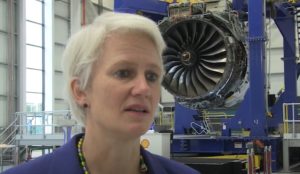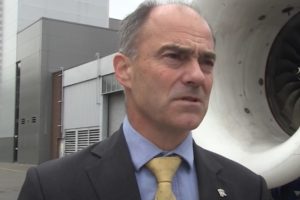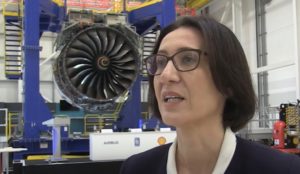In the run up to the COP-26 conference taking place in Glasgow at the end of this month, Mark Pilling catches up with the latest developments in decarbonisation from industry leaders from Airbus, Shell and Rolls-Royce at the engine manufacturer’s Derby facility. With the industry already pressing ahead with its Net Zero ambitions, he asks what government can do to help the sector achieve its goals.
Warren East, CEO, Rolls-Royce
“So the message is around high levels of ambition. We know that our technology can decarbonize long-distance aviation we now want to see governments match our technology ambition with their ambitions around policy that’s necessary to make this thing work.”
Anna Mascolo, President Global Aviation at Shell
“We are looking at COP-26 for yet another opportunity to bring the industry together and to start to see in governments, airlines, fuel suppliers continuing the ambition of zero emissions for industry, the same as we have seen at IATA AGM in Boston earlier on this month.”
Sabine Klauke, Chief Technology Officer, Airbus
“Airbus, as such, has a very ambitious goal because we are completely convinced that we can get there and that it’s totally feasible, so our target is to have the world’s first zero emission commercial aircraft flying by 2035.”
“There is no silver bullet, so we need to look at all technologies out there and towards the COP our full commitment is there and we are really willing to be at the forefront and bringing everybody together to do our part into this important goal of decarbonization of the aerospace sector.”
SAFs – a critical role to play
Sustainable aviation fuels will have a critical role to play in the industry over the next decades and although SAFs are already being produced, the industry leaders said so far, they were not being used enough. Production of SAFs will also need to be scaled up.
Sabine Klauke, Airbus
“It’s also looking at novel technologies and of course sustainable aviation fuels because the technology is there, the fuels are there, we are not using them enough. We are using them by less than zero point one per cent and we would need to go to over sixty per cent by 2050.”
Anna Mascolo, Shell
“We want to play our part when it comes to energy transition for the aviation sector. We aim to produce 2m tonnes of SAF by 2025. I think this is ten times that what is currently produced globally so it’s a big step up for the industry and also we aim to have at least 10 per cent of our sales by 2030 to be at least SAF.”
Warren East, Rolls-Royce
“In June this year, we said that our new engines that we are delivering today would be compatible with 100 per cent synthetic aviation fuel by 2023. That’s engines like the Dreamliner engine sat behind us, but there are a lot of airplanes already flying around with engines that are now no longer in production but they’re going to be flying around for another 20 years or so and what we’ve announced today is that we’re going to make sure that those engines are all compatible with 100 per cent sustainable aviation fuel by 2023 as well.”
Energy transition will be needed in aerospace, aviation and wider industry
Energy transition to cleaner sources is needed throughout the whole of industry. Rolls-Royce sees nuclear as providing a solution:
 Warren East, Rolls-Royce
Warren East, Rolls-Royce
“Energy transition is something hugely significant, it’s affecting all sectors. We play in the transport sector, in the energy sector, in the built environment as well and wherever we look, there’s a need for zero carbon energy. If I think about sustainable aviation fuel going into an engine like that, if I want to make it synthetically and capture the carbon directly from the atmosphere, maybe all of those operations require energy and in order for that synthetic aviation fuel to be truly net zero, that energy has to be zero carbon in the first place – and we need a lot of it.”
“That’s where our small modular nuclear reactors come in because I can put a nuclear reactor next to a synthetic aviation fuel plant that manufactures this synthetic aviation fuel and the zero carbon energy from the nuclear reactor can be used to power the plant and we can achieve a truly zero carbon solution.”
Investment case for cleaner energy
Energy transition will cost billions and needs to happen this decade. But the industry leaders said investors were clear that change needed to happen soon and that the business opportunities were out there.
Sabine Klauke, Airbus
“We do see a lot of willing full people coming together and I think it is really about having the investments in all the different sectors in the whole value chain in parallel so the technologies the infrastructure and also the industrialisation of the manufacturing of the fuels.”
Warren East, Rolls-Royce
“Investors can see that this change is going to happen anyway companies and businesses from big businesses like Rolls-Royce making nuclear reactors to provide the power to people who are creating the hydrogen, to people who are transporting the hydrogen around, to people who are fitting domestic boilers. There’s a whole chunk of business opportunity there.”
 Anna Mascolo, Shell
Anna Mascolo, Shell
“This is an industry that needs to transform. We know that the emissions we have today are around about 3 per cent. If we do nothing they will increase the 22 percent
“Society, consumers, you and I will not accept that. We expect the industry to change and, in the face of change, we need all parties to come together. I represent the fuel suppliers but we expect airlines to commit to, and signal that they want sustainable aviation fuels. We expect the engine manufacturers to have their engines ready for SAF and aircraft manufacturers the same. But, also, we want government to step in and work with us and the industry to accelerate the journey by having clear regulation frameworks, possibly having mandates being applied to the industry and making sure that you create an investment environment or an environment that is investable from a production perspective, from an infrastructure perspective and hopefully a better environment for our customers and, again, you and I can fly sustainably in the future.”

